48 - Jesse Haston's Family in the Civil War Years and After
Some Selected Highlights

Some of Daniel Haston’s grandsons and great grandsons joined the Union Army. Others, especially those who remained in Tennessee, chose to suit up in grey. None of the Tennessee Hastons I know of were slave owners. They were probably defending the right of states to decide their own laws and choose their own courses of action. Jesse Haston was the only son of Daniel for which slavery itself was probably a major issue in choosing a side to support.
Howard County, MO in the Heart of "Little Dixie"
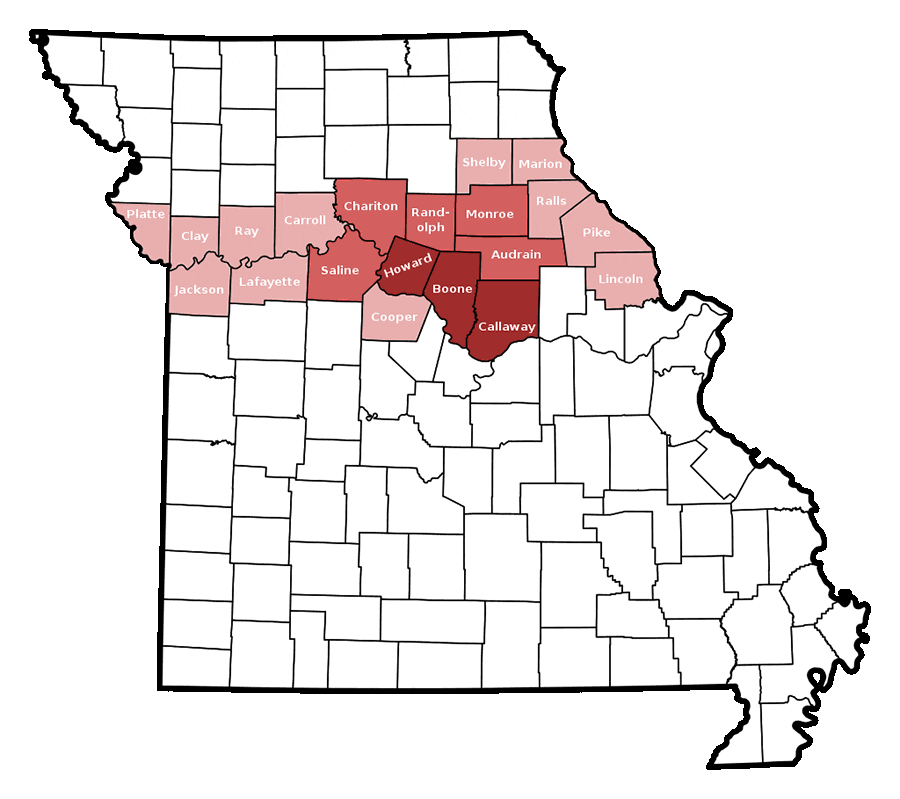
Little Dixie was a historic 13- to 17-county region along the Missouri River in central Missouri, United States. Its early European-American settlers were largely migrants from the hemp and tobacco districts of Virginia, and central Kentucky and Tennessee. They brought enslaved African Americans with them or purchased them as workers in the region. Because Southerners settled there first, the pre-Civil War culture of the region was similar to that of the Upper South. -Wikipedia
Consequently, this region was a major hot spot during the Civil War. The Union Army targeted it, Confederate sympathizers tried hard to protect it, and guerilla sniping and raiding was prevalent by enlisted soldiers, militia fighters, and civilian partisans on both sides. As a prominent slave owning family in Howard County, Missouri (the heart of Little Dixie), Jesse and his family paid the price for its choice of loyalties.
Thomas Jefferson Haston
Early in the war (January 26, 1862), Jesse’s son Thomas J. Haston “came in with Mr. M_____ and requested to take oath” – oath of allegiance to the Federal Government. Whether or not T.J. was pressured to swear the oath, we do not know.
I can only speculate about Thomas Jefferson Haston’s oath—which is risky busy for a historian—so please consider my thoughts as nothing but speculation. Knowing what was happening in “Little Dixie” of north-central Missouri in 1861-1862 and Jesse Haston’s pro-slavery bias, I’m guessing that Jesse’s son had participated in anti-Union activities that marked him as an enemy of the United States. As 1862 approached, rumors of the Union Army’s impending harsh orders regarding southern guerillas were beginning to circulate and Thomas Jefferson Haston may have decided to sign the oath rather than risk his life. From what I can tell, it appears that he remained out of trouble for the remainder of the war. He was referred to as Colonel Thomas J. Haston in the latter years of his life, but there is no evidence (that I have seen) to indicate he was in either army, other than an October 16, 1931 widow’s pension application for Federal service that apparently was rejected.

Abi Alburn Haston
Abi appears on the United States Civil War Draft Registration Records for 1863-1865 as being age 38, residing in Morris of Carroll County, Missouri and in Class 2* as a registrant.[i] And as of September 30, 1871, Abi A. Haston appeared on a United States Register of Civil, Military, and Naval Service, stationed in Newman of Jefferson County, Kansas. His salary was $12.[ii] A.A. Haston was identified as a “Trader” on the 1885 Kansas State Census.[iii] I have no record of Abi being a soldier, for either side, during the war, but he may have been a livestock trader for the Union Army.
*Class I was for those aged 20-35 as well as those 36-45 and unmarried. Class II is everyone else that registered.
[i] Record Group: 110, Records of the Provost Marshal General’s Bureau (Civil War); Collection Name: Consolidated Enrollment Lists, 1863-1865 (Civil War Union Draft Records); NAI: 4213514; Archive Volume Number: 3 of 3.
[ii] U.S., Register of Civil, Military, and Naval Service, 1863-1959, Volume 1, 590.
[iii] Kansas State Historical Society; Topeka, Kansas; 1885 Kansas Territory Census; Roll: KS1885_61; Line: 1.
[i] Record Group: 110, Records of the Provost Marshal General’s Bureau (Civil War); Collection Name: Consolidated Enrollment Lists, 1863-1865 (Civil War Union Draft Records); NAI: 4213514; Archive Volume Number: 3 of 3.
Battle of Glasgow, Missouri – October 15, 1864
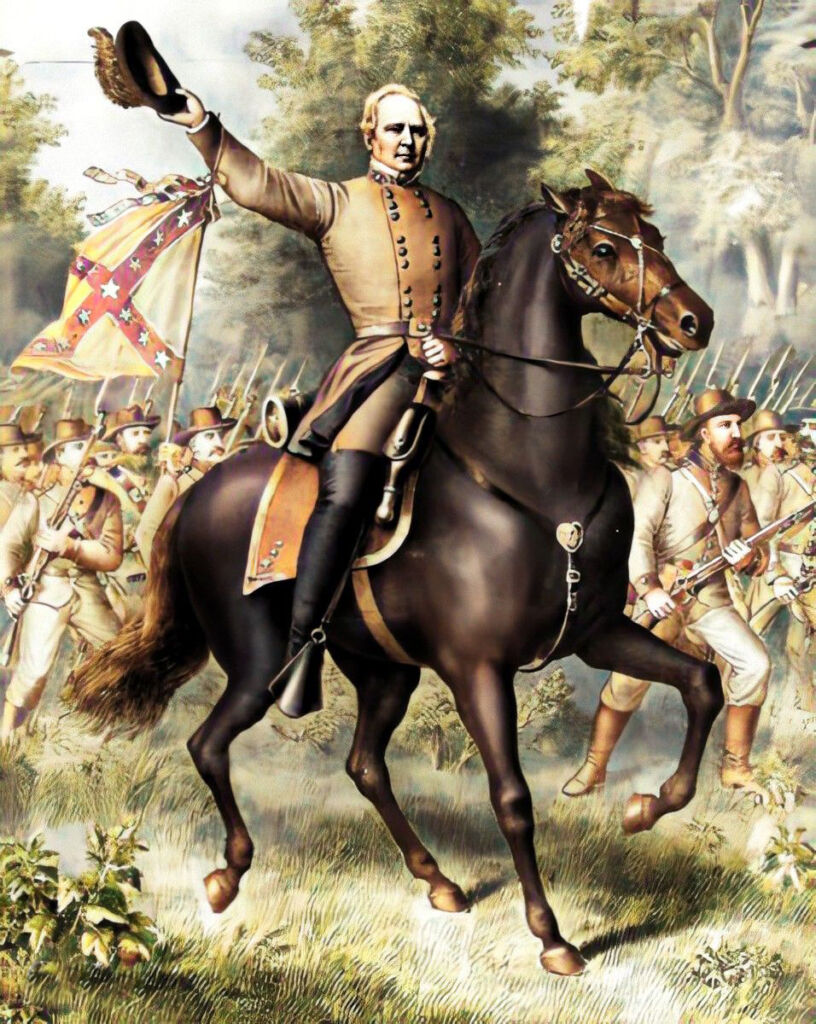
Confederate General Sterling Price, a plantation owner from Keytesville of Chariton County (adjacent to Howard County) and former governor of Missouri, led 12,000 rebel soldiers into Missouri in the fall of 1864. His initial goal was to capture St. Louis, but later perceived that the defenses of that city were too strong. Instead, on September 26-27 he attacked Fort Davidson at Pilot Knob, Missouri—a little fort that protected warehouses of military supplies, iron works in the Arcadia valley, and a train depot at the terminus of the railroad that ran from St. Louis.
After an embarrassing defeat at Pilot Knob, Price moved westward, by-passing the heavily defended Missouri capital, Jefferson City. It was (falsely) rumored that there was a large store of Yankee weapons in the town of Glasgow, so General Price sent General John B. Clark, Jr. with a detachment of approximately 1,800 men to capture Glasgow and some much-needed military supplies.
From the west side of the Missouri River, Confederates began shelling Glasgow, early on the morning of October 15, 1864. A couple of hours later, “1,700 to 2,000 rebels appeared on the south side of Glasgow to confront approximately 650 Union defenders.”[i] After a hard fight, the defenders were driven into the center of town and, finding themselves surrounded, were forced to surrender
[i] “Battle of Glasgow—October 15, 1864—Glasgow, Missouri,” Waymarking, accessed February 3, 2021, https://www.waymarking.com/waymarks/WMC9KP_Battle_of_Glasgow_October_15_1864_Glasgow_Mo.
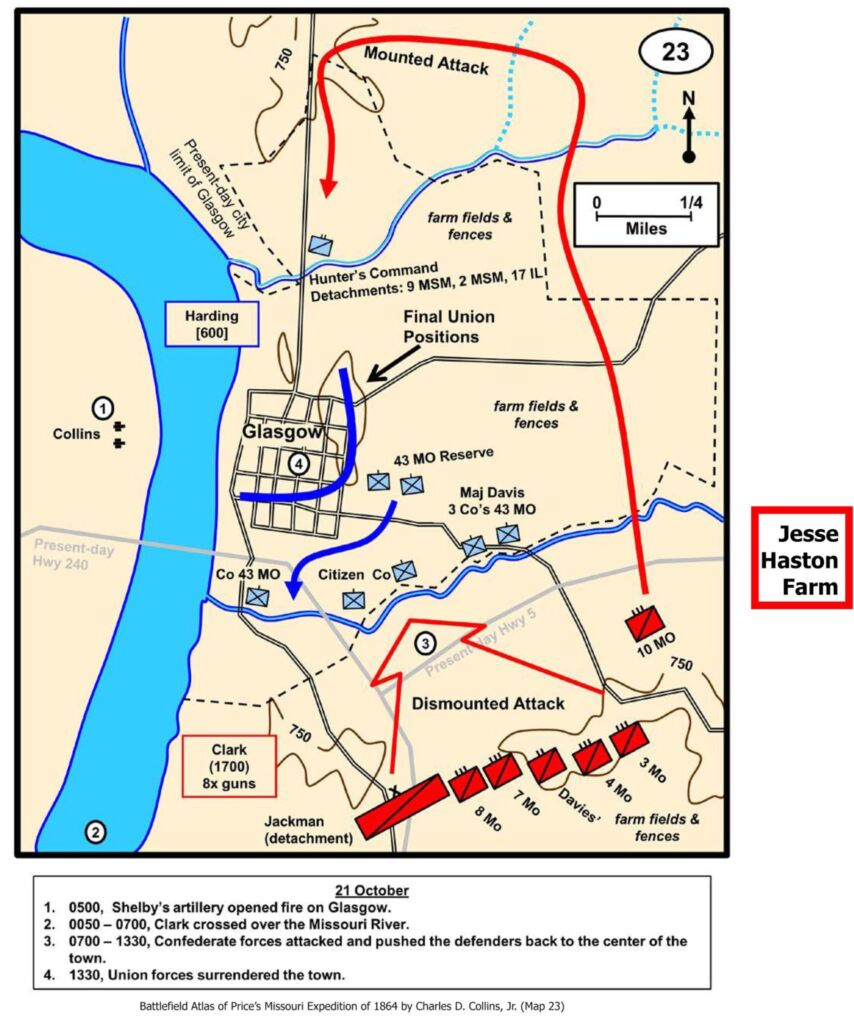
On October 16, the Confederates rejoined General Price and the main force and moved on towards Kansas City. On or about October 29, Glasgow was re-occupied by pro-Union Missouri militia who proceeded to exact revenge. “The militia executed at least a dozen Southern sympathizers, and burned their homes and businesses.”[i]
[i] Kenneth Westhues, “The Battle of Glasgow Was a Waste, a Small Victory on the Way to Defeat,” accessed February 3, 2021, https://www.kwesthues.com/BatGlsgw1-1410.html.
So, the Battle of Glasgow, Missouri did not end for the citizens of the little town when the southern army moved out. Jesse Haston was one of the unfortunate ones who experienced deadly vengeance from the Yankee army or its sympathizers.

November 8, 1864 – Jesse died in Glasgow, Missouri and was buried on his farm, located about two miles east of Glasgow. Jesse was considered a Southerner during the Civil War. The Northern troops raided his home during the war, taking everything of value, including a number of horses. He went to the Yankee headquarters at Glasgow, talked to them, and they let him have one horse to plow his garden. Members of the Federal state militia* followed him out of town, shot him, and took the horse. He died a few days later and is buried in the cemetery just east of his house.

Jesse, Jr. and Isaac Haston (sons of Jesse, Sr. and Elizabeth) in the Confederate Army
Other than some kind of (possible, but not confirmed) southern sympathizer action on the part of Thomas Jefferson Haston, there is no record of any of Jesse’s children being engaged on behalf of the Confederacy, until after their father was ambushed and murdered by the Union militia. But, in the later months of the war, brothers Jesse, Jr., and Isaac mustered into a battalion of Confederate Sharp Shooters.
June 7, 1865 – Jesse Haston, Sr.’s sons Jesse, [sic, Hayston] Jr.[i] and Isaac[ii] were enrolled in Company C of Searcy’s Battalion of Missouri Confederate Sharp Shooters. They appeared on a roll of prisoners of war, paroled at Alexandria, Louisiana on June 7, 1865. Isaac was a private and his slightly older brother, Jesse, was a corporal.
[i] “Jessee Hayston,” Fold3.com, accessed February 12, 2021, https://www.fold3.com/image/185506005 and /image/185506006.
[ii] “Isaac Haston,” Fold3.com, accessed February 12, 2021, https://www.fold3.com/image/ 185506002 and /image/ 185506003.
Searcy’s Battalion of Sharpshooters was commanded by Col. James Jasper Searcy. Searcy’s former regiment “Searcy’s Regiment Missouri Cavalry,” became under strength so was it dismounted and downgraded to a battalion and renamed. There are very few records for this regiment, but it was formed in early 1865.
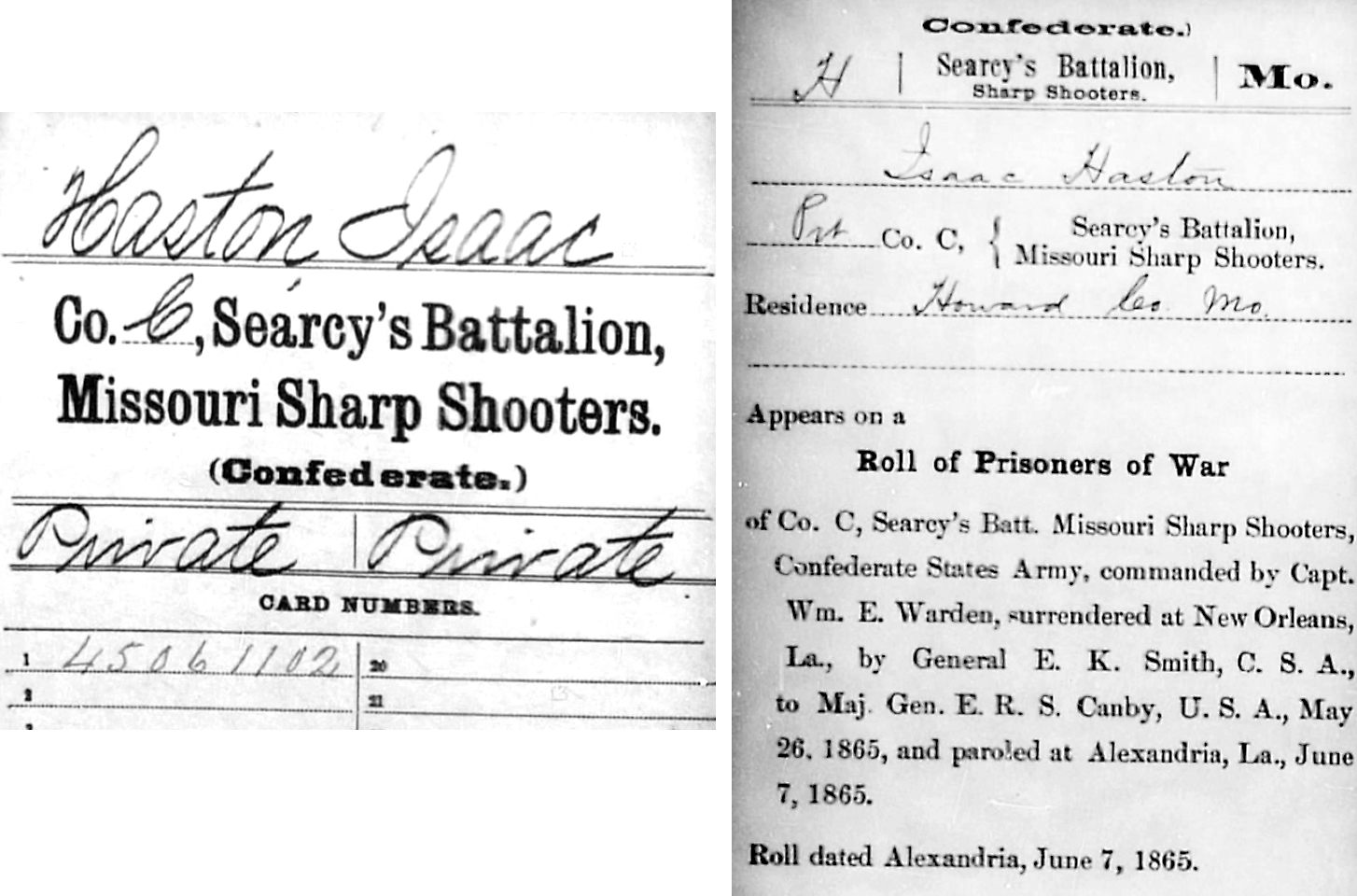
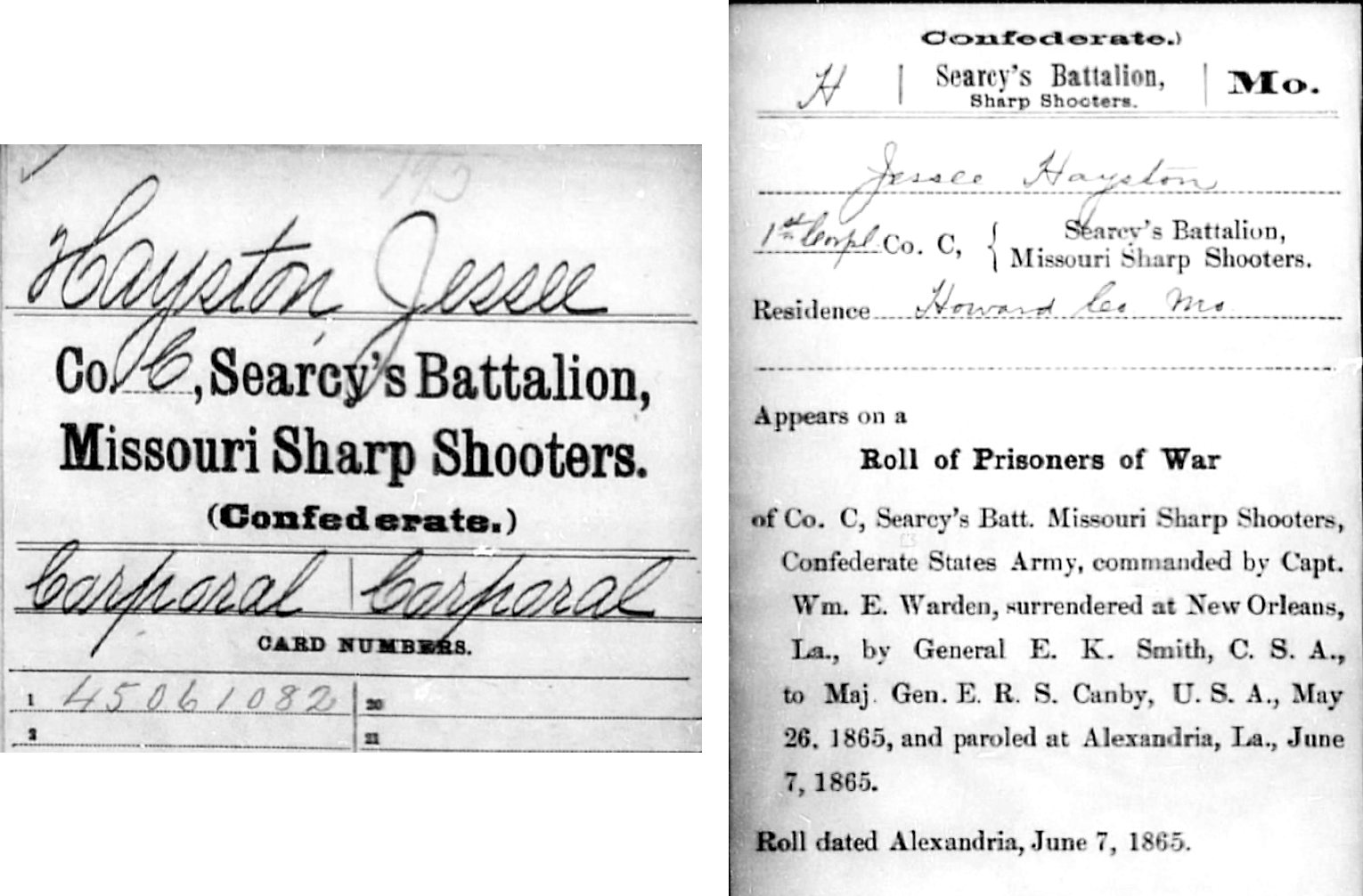
December 12, 1888 - Attempted Sexual Assault on Annie Haston
Annie, was the youngest daughter of Jesse Haston.

The event was reported in newspapers across the state. Jesse Haston, Jr., Annie’s brother, chased one of the assailants, Frank Jenkins, and wounded him.[i] Jenkins was sentenced to five years in the state penitentiary. His co-assailant, Ollie Thixton
was lynched on January 20, 1891 in Fayette of Howard County for a similar attempted assault on another woman.[i]
[i] “Lynched at Fayette,” The Sedalia Weekly Bazoo (Sedalia, Missouri), January 27, 1891, 3.
[i] “A Brother’s Vengeance,” The Butler Weekly Times (Butler, Missouri), December 19, 1888, image 7.

1892 - Jesse Haston, Jr. - Nominated for Montana State Treasurer
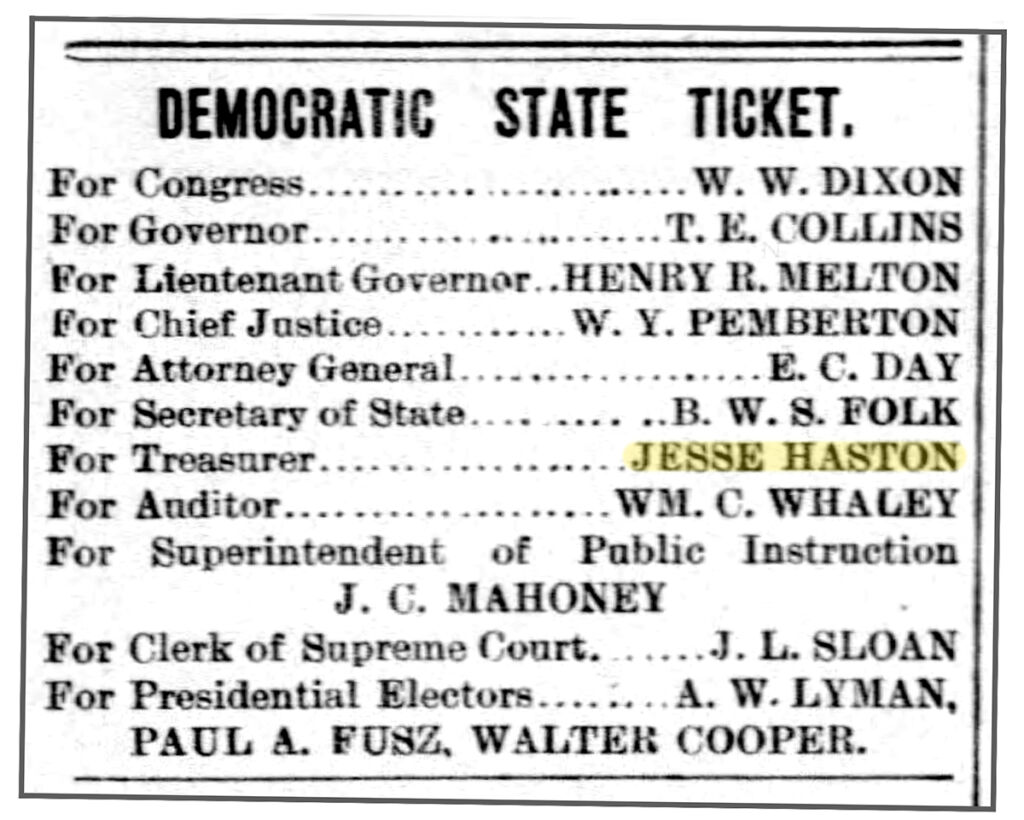
On the first day of August 1879 at Camp Sheridan Nebraska, Jesse Haston, Jr. entered the employment of the Niobara Cattle Company as a cowboy and the tenderfoot of the outfit and by hard work and always being faithful to the trusts confided to him, in a few years having passed through all the phases of cowboy life and the cattle business he became manager of the company.
Jesse Haston, Jr. ran for Treasurer for the State of Montana in 1892, when Democratic Grover Cleveland defeated Benjamin Harrison for President of the United States. However, the following entire Democratic State ticket was defeated.[i]
[i] “Democratic State Ticket,” Great Falls Tribune (Great Falls, Montana), November 8, 1892, 2.
Obituary of Ann Juliet Barnes Haston
A good woman Has gone to her reward. Last Wednesday afternoon, December 28, her family physician drove into town through the snowstorm and announced to a circle of friends — tried and true — that the end had come and that a long and eventful life had closed. The expressions of regret and grief were mingled with expressions of admiration for her character.
One said — a prominent businessman here — “she was the most conscientious woman I ever knew.” Another said — he is now a banker in the city — “I lived on a farm near Mrs. Haston for years; a better woman never lived. I saw her under all circumstances, and she is a remarkable woman. Yet, another — connected with Pritchett College, who knew her through long years, added this testimony: “She was not only a good woman, but a brave woman — a woman of strong character and brave at heart. Among these familiar friends there was sincere mourning at the announcement of her death.
Dr. Bishop, her pastor, conducted the funeral at the home, some two miles east of Glasgow, on Friday at 11 a.m. Notwithstanding the storm a large concourse of friends were present. The text was: “Thou shalt come to thy grave at a full age, like a shock of corn cometh in his season,” Job 5:26. The pastor spoke of the long life of 72 years which had closed, of the eventful scenes through which that life had passed, of the forty years of widowhood which constituted so large a part of it, and of the fidelity and Christian fortitude which characterized the career now forever closed.
The burial was in the cemetery at the homestead, the services at the grave being conducted by the Rev. Mr. Watts, a neighbor and a valued friend. Mrs. Haston was Miss Ann Juliet Barnes, and was born in Baltimore, Maryland, February 5, 1832. On the 16th of February 1853, she was married to Mr. Jesse Haston. This union brought her the care of two boys, ten and twelve years old, children of Mr. Haston by a former wife. Her own children were six in number, one dying in infancy and one at the age of 18 years.
Her greatest sorrow, the event that wrung her heart most of all, was the death of her husband, who was shot down and mortally wounded on the streets of Glasgow the day after the battle of Glasgow during the civil war and during the disorder incident to that battle. From this shock, though she lived 40 years hereafter, she never recovered.
The four living children of Mrs. Haston are Mrs. A.E. Dandridge, of Nelson, Mo.; Mrs. J.H. Jones of Charleston, West Virginia, Miss Ida Haston and Miss Anie Haston, the two latter being now the sole occupants of the home. To these two in an especial manner the sympathy of the entire community goes out. But in their loneliness and bereavement they have a rich heritage in the memory of their mother and the heartfelt regard of the entire community. “Blessed are the dead, that die in the Lord.” “W.F.B”
As with all of these articles, there is much more to be said about the Jesse Haston family–70+ pages in the more complete (larger) edition of the book that is being written now.
If you appreciated this article, please share it with others who might also enjoy it.

